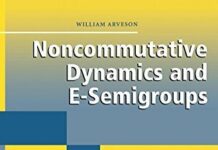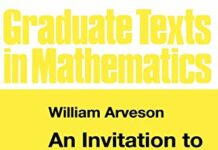
Ebook Info
- Published: 2002
- Number of pages: 149 pages
- Format: PDF
- File Size: 2.15 MB
- Authors: William Arveson
Description
This book presents the basic tools of modern analysis within the context of the fundamental problem of operator theory: to calculate spectra of specific operators on infinite dimensional spaces, especially operators on Hilbert spaces. The tools are diverse, and they provide the basis for more refined methods that allow one to approach problems that go well beyond the computation of spectra: the mathematical foundations of quantum physics, noncommutative K-theory, and the classification of simple C*-algebras being three areas of current research activity which require mastery of the material presented here.
User’s Reviews
Editorial Reviews: Review From the reviews:MATHEMATICAL REVIEWS”This book, a product of the author’s own graduate courses on spectral theory, offers readers an expert and informed treatment of the major aspects of the spectral theory of Hilbert space operators. It is evident that a great deal of thought has gone into the choice of topics, the presentation of the results, and the design of exercises. The text is clearly written and the material is motivated in a fashion that a newcomer to the subject can readily understand…Graduate students and experienced mathematicians alike will enjoy and benefit from a close reading of this well-written book.””I find that Arvesen’s book is a fine addition to the existing literature. Each section has several interesting, doable exercises. Arvesen tells us that the book is based on graduate courses taught at Berkeley to first and second year PhD students. In Europe, it should be possible to teach parts of the book (e.g. chapters 1 and 3) to students at the Master level.” (Alain Valette, Bulletin of the Belgian Mathematical Society, Vol. 12 (1), 2005)”The book is written in an easily readable style, the composition is clear, many examples and a great number of exercises help the reader in understanding the material.” (Endre Durszt, Acta Scientiarum Mathematicarum, Vol. 69, 2003)”This book … offers readers an expert and informed treatment of the major aspects of the spectral theory of Hilbert space operators. It is evident that a great deal of thought has gone into the choice of topics, the presentation of the results, and the design of exercises. The text is clearly written and the material is motivated in a fashion that newcomers to the subject can readily understand. … Graduate students and experienced mathematicians alike will enjoy and benefit from … this well-written book.” (Douglas R. Farenick, Mathematical Reviews, Issue 2001 j)”I used (part of) the book last year for a small class … at UNSW, and it eased the task of writing the lectures considerably. … This is very much a book written for students. There are lots of nice examples and informative exercises. … I was quite struck by the number of places where the writing provided me with new insights. … this book is highly recommended for anyone … who wants to acquire some of the basic tools of modern analysis.” (Ian Doust, The Australian Mathematical Society Gazette, Vol. 30 (3), 2003)”The aim of the present book … is to make the reader acquainted with the basic results in spectral theory, needed for the study of more advanced topics … . The book is a clear, short and thorough introduction to spectral theory, accessible to first and or second year graduate students. As the author points out in the Preface: ‘this material is the essential beginning for any serious student in modern analysis’.” (S. Cobzas, Studia Universitatis Babes-Bolyai Mathematica, Vol. XLVII (4), 2002)”In this book the basic tools of modern operator theory are presented. The notion of a spectrum of an operator is treated with the more abstract notion of spectrum of an element of a complex Banach algebra. … Each part of the book contains interesting exercises, which give many new insights into further developments and enhance the usefulness of the book.” (F. Haslinger, Monatshefte für Mathematik, Vol. 138 (3), 2003)”The book is well-written and provides a large variety of results, ranging from the historical roots to the frontiers of contemporary research. … the book may be of interest for those who have already got in touch with classical spectral theory during a course on functional analysis and operator theory, and want to learn something about the interconnections of spectra with abstract fields like C*-algebras or modern K-theory.” (Jürgen Appell, Zentralblatt MATH, Vol. 997 (22), 2002)”This is a nicely written textbook which can be recommended to every student of modern analysis. The text, already lively, additionally gains through a lot of exposed Remarks. Further, any section contains a lot of Exercises (together nearly 175) … for which sometimes hints are given.” (J. Synnatzschke, Zeitschrift für Analysis und ihre Anwendungen, Vol. 21 (2), 2002)“Presents a tightly structured whole, fitted into an orbit of around 130 pages, and provides the reader with ‘many deep and important ideas [that] emerge in natural ways.’ … Little more needs to be said about this excellent book: it has plenty of good exercises, it is well written, and reaps the benefit of coming from the author’s experience with this important material in his graduate courses at Berkeley. It is indeed a very good textbook in a fundamental and centrally important subject.” (Michael Berg, The Mathematical Association of America, May, 2012) From the Back Cover This book presents the basic tools of modern analysis within the context of the fundamental problem of operator theory: to calculate spectra of specific operators on infinite dimensional spaces, especially operators on Hilbert spaces. The tools are diverse, and they provide the basis for more refined methods that allow one to approach problems that go well beyond the computation of spectra: the mathematical foundations of quantum physics, noncommutative k-theory, and the classification of simple C*-algebras being three areas of current research activity which require mastery of the material presented here. The book is based on a fifteen-week course which the author offered to first or second year graduate students with a foundation in measure theory and elementary functional analysis.
Reviews from Amazon users which were colected at the time this book was published on the website:
⭐This is an exceptional book, best read after a course on functional analysis that has already covered the foundations: Hahn-Banach theorems, open-mapping and closed-graph theorems, duality (especially for C(X)), Hilbert spaces. It gives an operator theory perspective illustrated with a class of important but very concrete examples, the Toeplitz operators, and derives their spectrum for special cases.A key tool is the Fredholm index and Atkinson’s theorem, which the book develops, unusually, in full generality, that is, as results of infinite-dimensional linear algebra without much reference of the underlying topological structures. In this approach the proofs yield the strongest version of Atkinson’s theorem: an operator is Fredholm iff it is invertible up to a finite rank perturbation (and not just up to a compact perturbation, significant due to Per Enflo’s example of a separable, reflexive Banach space with compact operators that are not norm limits of finite rank operators). One of the exercises is to prove that the range of a bounded operator is closed if it has finite codimension; this provides the link to applications to bounded operators. The treatment of Fredholm theory here is one of the great strengths of this book; it’s unlikely to feature in a first course in functional analysis and is often absent in more advanced books on operator algebras.There is also an excellent, clear but concise, exposition of Gelfand’s theory of commutative Banach algebras and the application of the functional calculus to derive the spectral theorem for bounded normal operators on a Hilbert space, as well as a restatement using the traditional approach based on spectral measures.There are many exercises throughout the book, often requiring some insight, rather than long calculation, to get the exact point of the exercise. These include concrete examples of multiplication operators on L2(T) (square integrable functions on the circle) vs multiplication operators on direct sums of L2([0,1]) and specific operators involving the unilateral shift to contrast Weyl spectrum and essential spectrum. One great set of exercises derives the Stone-Cech compactification as the spectrum of the algebra of bounded continuous functions on a locally compact Hausdorff space; comments on this in the book also serve as reminder of some of the finer points of general topology: examples of compact Hausdorff spaces with sequences that have no convergent subsequence, only convergent subnets.The last two sections of the book have the GNS construction and the Gelfand-Naimark theorem on the existence of states in a C*-algebra. The book ends with a remark, without proof, that pure states correspond to irreducible representations. What an ideal segway leading to Arveson’s famous book,
⭐, which starts off with states and representations and continues to multiplicity theory, Type I C*-algebras and Borel structures!I wrote this review after reading this book a second time, gaining a lot of insights that I may have missed the first time. It served as one more reminder of the privilege of having been able to study operator algebras at Berkeley under Professor Arveson and will surely convey some of that excitement to every reader.
⭐The word “spectrum” comes from quantum theory, as does thesubject of operators in Hilbert space. Since the early days, thesubject has grown, and branched out in a variety of directions.This fact has perhaps made it difficult for an instructor tochose a book from which to teach the fundamental ideas;–those ideas in a subject that stay constant, even when thefashions change. The topics covered in Arveson’s book are relevant now, and are likely tobe useful decades from now. They are beautifully presented.–The material and the format have been tested in courses;– and this book represents a formula that works!
Keywords
Free Download A Short Course on Spectral Theory (Graduate Texts in Mathematics, 209) 2002nd Edition in PDF format
A Short Course on Spectral Theory (Graduate Texts in Mathematics, 209) 2002nd Edition PDF Free Download
Download A Short Course on Spectral Theory (Graduate Texts in Mathematics, 209) 2002nd Edition 2002 PDF Free
A Short Course on Spectral Theory (Graduate Texts in Mathematics, 209) 2002nd Edition 2002 PDF Free Download
Download A Short Course on Spectral Theory (Graduate Texts in Mathematics, 209) 2002nd Edition PDF
Free Download Ebook A Short Course on Spectral Theory (Graduate Texts in Mathematics, 209) 2002nd Edition

